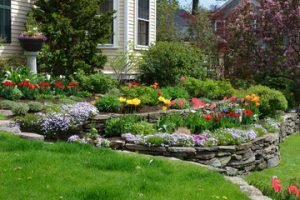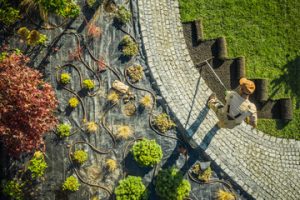Oceanic Landscaping is the art of creating a beautiful outdoor environment that reflects the homeowner’s style and personality. It involves a variety of skills, including soil testing, planting, water management, and maintenance.

Mulching frequently helps conserve water by reducing evaporation and suppressing weeds. Also, using regionally appropriate plants requires less supplemental watering.
Color helps to set the tone for a landscape design, whether it be creating warmth with reds and yellows or coolness with greens and blues. It can also be used to create contrast to make certain landscape elements stand out. Color can also be incorporated to cultivate unity in a garden or landscape by utilizing the same color palette for plants, flowers, building materials, and even patio furniture.
This paper uses a social semiotic approach to decipher the dramatic changes in color language of urban and landscape design over the past 20 years. By collecting 692 design projects that feature saturated colors, this paper classifies color practices based on Kress and Van Leeuwen’s model of social communication to explore how different motivations have driven the emergence of these new color practices in urban and landscape design.
Form
In landscape design, form is the shape of a plant, a feature or a hardscape element. Form ties together the other design elements into a cohesive composition and serves an important functional role. For example, a well-designed rainwater management system (functional) serves its purpose while creating a pleasing aesthetic (form). A well-designed garden or public space balances function with form by combining elements like shaded seating areas and art installations that reflect the culture of the area.
Shape is arguably the most important form factor in your landscape because it creates structure and definition for your plants. The shapes of flowerbeds, ponds and facets of architecture create the basis for the overall design. Plants also have their own natural forms – rounded, vase-like, pyramidal, weeping, spreading and free-form. The shape of shrubs defines their overall form and function – rounded, mounded or cascading plants work well in taller scenes while spiky or upright ones are more effective in lower areas.
Line is another critical element in the composition of a landscape because it controls movement and direction within the space. It can define pathways and walkways, or it can highlight a water feature, tree or other focal point. Straight lines can give a formal feel to the landscape, while curved lines evoke a more natural feeling.
Texture is an important aspect of form because it provides visual contrast and evokes emotion. Touching the soft, feathery fronds of an ornamental grass and feeling the rough bark of an oak tree are both sensory experiences that enhance your enjoyment of the landscape. Texture also adds interest by providing a variety of textures in the landscape – smooth or rough, fine or coarse.
The final key aspect of form is repetition, which can be used to establish a rhythm in the design. However, it must be used with caution because too much repetition can lead to monotony. It’s best to mix up the use of form, color and texture to create a balanced and interesting landscape. In addition, the right balance of these five key elements appeals to the eye and creates harmony in the landscape.
Lines
Lines are important for defining the shape and form of a landscape and the way the eye moves through it. They create patterns, develop spaces, control movement, establish dominance and create a cohesive theme in the landscape. There are three primary line types: bedlines, hardscape lines and plant lines. Bedlines are created when a plant bed edge meets another material such as turf, gravel or patio pavers. They connect plant material to the house and delineate the garden area. Hardscape lines are created when the edge of a built feature, such as a path, driveway or fence, is visible against a background. Plant lines are created when a vertical element, such as a tree or a plant canopy, is set against the sky or another backdrop.
The shape of the line is just as important as its location within the garden. Straight lines are often associated with formal gardens and accentuate symmetry. They move the eye quickly to focal points and do not allow for distractions. Curved lines, on the other hand, are more natural and convey a relaxed feel. They also help to tie spaces together and make the eye move at a slower rate.
The proportion of a landscape is another essential element to consider. Proper proportion is the amount of space occupied by a particular feature or element compared to the whole landscape. For example, a tall, narrow tree or structure will take up more space than a short broad shrub or groundcover plant. Similarly, a pond with a wide surface will look larger than a small, shallow one.
When designing your property line landscaping, it is important to use a variety of plant types and hardscape features to create a visual texture that will stand out against the home. Looming trees, quaint shrubbery, sprawling vegetables and simple grasses are all great options for creating a property line that is not only aesthetically pleasing but also defines the boundaries of your yard. For a more dramatic effect, consider incorporating a water or fire feature that will add to the privacy of your backyard.
Space
A well-balanced landscape utilizes space to create a natural and inviting outdoor environment. This is achieved by defining separate spaces with unique characteristics, utilizing different shapes and forms, and balancing mass, line and texture. The use of color adds visual interest and helps to pull the landscape together.
A landscape is often a focal point of a property, and the way that a homeowner chooses to highlight this feature can influence its overall look. Focal points in a landscape can be created by using plants, trees or structures to create a specific visual shape or by creating an interesting focal point through the use of colors, lines, textures, etc.
The scale of a plant or object is important because it determines how it fits into its surroundings. It is essential that all components of a landscape be proportionate to one another, so that a small flower bed does not get lost within a large lawn or garden. Scale is also important when establishing a hierarchy between the elements of a landscape. The smaller components need to be able to stand out against the larger ones in order to be recognized and appreciated.
Lines are a key element of any landscape design. They can be perceived or physical, and they can create a sense of movement and direction for the eye. Whether it is the line of sight from your house into your yard, or a walkway leading to a water feature, lines are the building blocks that help to define and organize a landscape.
Keeping things simple is an important aspect of good landscape design. Overcomplicating a design disrupts the rhythm and balance of the space and can make it appear chaotic and disorganized. The concept of simplicity can be applied to all aspects of a landscape, from the use of plants and flowers to the construction materials used in pathways and patios.
Not only does a well-designed landscape have aesthetic value, but it can also have many practical benefits for homeowners. Adding trees, for example, can improve air quality by removing carbon dioxide and releasing oxygen. In addition, landscaping can make a property more attractive and increase its resale value.
